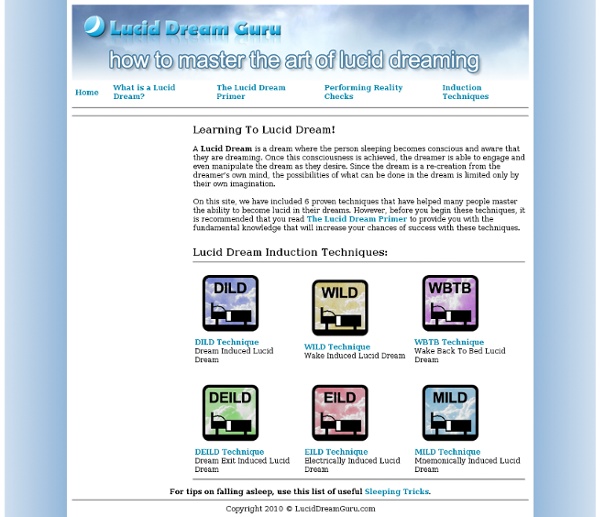



Hyper Lucid Dreaming Lucid Dreaming Techniques: A Guide To Lucid Dream Induction Here are my top lucid dreaming techniques for beginners. They range from simple memory exercises (like Reality Checks and Mnemonic Induction of Lucid Dreams) to specialized meditation (like Wake Induced Lucid Dreams). Lucid Dreaming Tutorials For step-by-step tutorials and audio tools for lucid dream induction and exploration, check out my Lucid Dreaming Fast Track study program for beginners and beyond. 52 Ways to Have Lucid Dreams A complete list of 52 ways to have lucid dreams - based on visualization, memory, supplements, sleep cycles and more methods than you can shake a stick at. How to Have Lucid Dreams A summary of my favorite lucid dreaming techniques, from improving dream recall, to programming your dreams, to meditation and self-hypnosis. How to Remember Your Dreams To lucid dream, you must first remember your dreams. Keeping a Dream Journal How to Perform Reality Checks How to Improve Your Self Awareness Lucid Dreams and Prospective Memory Dream Induced Lucid Dreams (DILDs)
How To Stay Lucid in Dreams and Increase Dream Intensity This article will teach you exactly how to stay lucid in dreams - transforming a few brief seconds of lucidity to many long, memorable lucid experiences. I have included a number of dream stabilizing techniques below, based on Dr Stephen LaBerge's lucid dreaming experiments and my own personal experiences. My first lucid dreams were very short - we're talking seconds. I would realize I was dreaming and run around telling everyone about it. This is a common pattern for newbie lucid dreamers. You absolutely have to keep a cool head, or you'll just wake up. So next time you become lucid, immediately perform these simple dream stabilizing techniques to increase your self awareness in an instant. How To Prolong Lucid Dreams 1. 2. 3. 4. 5. If you notice the dream is slipping away (losing color and detail): 6. 7. My Longest Lucid Dream As soon as I learnt how to stay lucid, my dream world exploded. My lucid dreams can last up to one hour, sometimes as part of an even longer dream scenario.
How To Avoid These Two MAJOR Lucid Dreaming Mistakes!! | Lucidology A question I got which touches on two common mistakes: You know when you say I am supposed to stay awake and convince my body to go to sleep. First of all once I roll the whole lead blanket feeling vanishes. A lot of people wonder, why does “stop, drop and roll” involve moving your arms and rolling over if the whole trick to getting into waking sleep paralysis is to stay perfectly still? SDR is really about getting rid of the last bits of muscle tension. So if the final roll stage messes it up then don’t roll. The second mistake is a huge one that I have to repeat a lot. Don’t try to keep your mind awake!!! *****Just fall completely asleep and let the timer make you become lucid Let me repeat that again. When you’re using the Lucidology 101 methods, do NOT try to stay awake when you’re relaxing into a wake-induced lucid dream!! It sounds strange but the easiest way to have a WILD is to fall totally asleep. That’s how you get deep enough in your subconscious without using visualizations.
Lucid dreaming academy | Lucidipedia.com Lucid Dreaming By lucid dreaming, you can gain complete control over the one place that no one will ever care about: your imagination. Just The Facts Lucid dreaming is a scientifically proven phenomenon. While some get into lucid dreaming in order to treat chronic nightmares, or to experience all facets of the human experience, approximately 99.8% of people use it as a tool for cheap and interactive 3D porn. How to Take Control of Your Dreams: So, you've doubled your weight over the past five years, you own a record-shattering collection of greasy pizza boxes and broken aspirations, and you're beginning to consider installing a toilet bowl in the place of your computer chair? In order to even begin to get control over your dreams, there are a few preliminary tasks you must complete. Your fake and imagined rendition of Yvonne won't care how much your cry before, during, and afterward! The Tasks: 1. "What?" Calm down! 2. Your dreams are not unique, and that is a wonderful thing. Wake Initiated Lucid Dreams:
Erotic Lucid Dreaming: Exploring Sex & Spirit | The Dream Studies Portal This is a topic that never goes out of style. Exploring sexuality safely within the confines of the dream world is one of the prime motivations for learning how to lucid dream. The promise of “exciting dream sex” is a marketing hotspot, so to speak, for beginning lucid dreaming guides, books, and dozens of dubious meditation CDs. What these guides don’t tell you, of course, is how difficult it is to perfect the art of exploring erotic energy in dreams, and what the pitfalls are along the way. Let’s start with a little question and answer about the basics and then move on to the possibilities of exploring sex and sensuality in dreams. Q: Is it true that you can learn how to lucid dream and have sex with your ultimate fantasy? Q: Are dream orgasms real? Q: What about wet dreams? REM sleep is simply exciting from a biological standpoint. Q: Why are my lucid dreams so erotically charged? Q: I had a sexual lucid dream about someone unexpected… what does it mean? The Carrot on the String